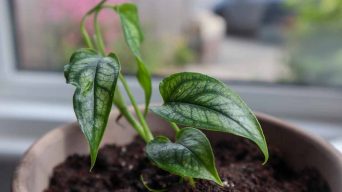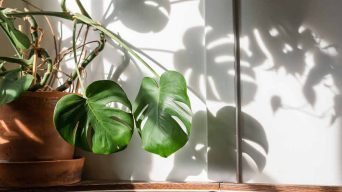Water your Monstera plant every one to two weeks, allowing the top inch or two of soil to dry out completely before watering again.
Like most people, you probably think that Monsteras are low-maintenance plants.
And while it’s true that they’re pretty easy to take care of, you still need to know a few things to keep them healthy and looking their best.
This article will discuss how often you should water a Monstera plant and provide tips for keeping it happy and thriving!
How Often To Water Monstera Plants?
The frequency with which you water your Monstera plant will depend on a few factors, including the size of the plant, the pot it’s in, the type of soil, and the climate.
In general, though, most Monsteras, including the Monstera deliciosa and the Monstera adansonii, need to be watered every one to two weeks. Allow the top inch or two of soil to dry out completely before watering again.
They’re also pretty tolerant of drought, so if you’re unsure how often to water, it’s better to err on the side of too little rather than too much.
Factors That Affect Monstera Watering Frequency
As we mentioned, a few factors can affect how often you need to water your Monstera plant.
Let’s take a closer look at each one:
Climate and Temperature
If you live in a hot, dry climate, you may need to water your Monstera more often.
On the other hand, if you live in a cooler, wetter climate, you may only need to water it every two to three weeks.
Monsteras can suffer from too much water in humid climates, so adjust your watering schedule accordingly.
Humidity Levels
Monstera plants need high humidity levels to thrive, so if your home is dry, you may need to water your plant more often.
The ideal humidity level for Monsteras is between 60-80%.
If you need to know the humidity levels in your home, you can purchase a hygrometer to measure it.
Type of Soil
The type of soil you’re using can also affect how often you need to water your Monstera.
If you’re using a fast-draining potting soil mix, you’ll need to water more often than if you’re using a slower-draining soil mix.
When in doubt, always check the soil before watering to see if it’s dry.
Pot Size
The size of your Monstera plant pot will also affect how often you water it.
Smaller pots dry out more quickly than larger pots, so if you have a Mini Monstera in a small pot, you may need to water it weekly.
Larger pots can usually go longer between watering, so every one to two weeks is generally sufficient.
Pot Type
The type of pot you’re using can also affect how often you need to water your Monstera.
Pots made of materials like clay or terracotta tend to dry out more quickly than plastic or metal.
If you’re using a pot that dries out quickly, you may need to water your plant more often.
Light and Location
The amount of light your Monstera plant is getting can also affect how often you need to water it.
Montera plants need bright indirect light to thrive. If your Monstera is getting too much direct sunlight, it will dry out quickly and need to be watered more often.
On the other hand, if it’s not getting enough light, it will start to yellow and may need to be watered less often.
Airflow
The amount of airflow in your home can also affect how often you need to water your Monstera.
If your home is very dry, the air will start to suck the moisture out of the soil, and your plant will need to be watered more often.
On the other hand, if there’s too much airflow, the soil will dry out more quickly, and your Monstera will need to be watered more often.
How Often To Water a Monstera in Summer?
You may need to water your Monstera more often than in other seasons in the summer.
The hotter temperatures and longer days will cause the plant to dry out more quickly.
If you live in a hot climate, you may need to water your Monstera every week during the summer months.
Check the soil before watering Monstera plants to ensure it’s completely dry.
How Often To Water a Monstera in Winter?
You may need to water your Monstera plant less often than in other seasons in the winter.
The cooler temperatures and shorter days will cause the Monstera to dry out more slowly.
If you live in a cold climate, you may only need to water your Monstera every two to three weeks during winter.
Also, Monstera plants do not require as much water in winter because they are dormant.
How To Tell if a Monstera Needs Water
The best way to tell if your Monstera needs water is to check the soil.
The top inch or so of the soil should be dry to the touch before you water your plant again.
You can also stick your finger in the soil up to the first knuckle; it’s time to water if it feels dry.
Another way to tell if a plant needs water is by looking at the leaves. If the Monstera leaves are drooping, that’s usually a sign that the plant is thirsty.
Monsteras are pretty good at telling you when they need water, so pay attention to your plant; it will let you know when it’s time to give it a drink.
It’s essential to tell when a Monstera is under or overwatered.
These are two of the most common problems people have with their plants, and they can be easily avoided if you know what to look for.
How To Tell if Monstera Plant Is Overwatered
A common problem people have with their Monsteras is overwatering.
This can happen if you water your Monstera plant too often or if you water it with too much water at once.
You can identify an overwatered Monstera by looking for these signs:
The Leaves Are Yellow or Brown
When a Monstera is overwatered, the leaves will turn yellow or brown and develop root rot.
This is because the roots are not getting enough oxygen and are starting to rot due to the excess water.
The Leaves Are Drooping
Another sign of overwatering is when the leaves start to droop.
This happens because the Monstera is not getting enough water to the leaves, which are starting to wilt.
Plants cannot photosynthesize correctly when they are overwatered, so they start to droop as a way of conserving energy.
There Is Water Standing in the Pot
If you see water standing in the pot or on the leaves after you’ve watered your plant, that’s a sign that you’re overwatering.
When you water your plant, the water should be able to drain out of the pot quickly.
If it can’t, the roots are sitting in water and not getting the oxygen they need.
The Soil Is Soggy or Mushy
If the soil feels soggy or mushy, that’s another sign of overwatering.
You should be able to easily stick your finger into the soil without it feeling wet or muddy.
If you can’t, there’s too much water in the pot, and the roots are drowning.
The Stems Are Weak and Spindly
When a Monstera is overwatered, the stems become weak and spindly.
This is because the roots cannot correctly support the plant’s weight.
The leaves may also start to fall off if the stems are too weak.
There Is Mold or Mildew on the Soil or Pot
If you see mold or mildew on the soil or pot, that’s a sign that your plant is overwatered.
Mold and mildew thrive in damp, dark environments, so if you see them on your plant, it means there’s too much moisture.
How To Tell if Monstera Plant Is Underwatered
Underwatering is another common problem people have with their plants.
This can happen if you don’t water your Monstera plant often enough or if you need to use more water when you do water it.
You can identify an underwatered Monstera by looking for these signs:
The Leaves Are Curling Inward
One of the first signs of underwatering is when the Monstera leaves start to curl inward.
This happens because the plant is not getting enough water, trying to conserve moisture.
The Leaves Are Turning Brown or Yellow
Another sign of underwatering is when the leaves turn brown or yellow.
This happens because the plant is not getting enough water or nutrients, and the Monstera is starting to die.
The Soil Is Dry
If the soil is dry, that’s a sign that you need to water your plant.
The soil should be moist but not wet. If it’s dry, the roots need to get the moisture they need.
The soil may also feel crumbly or powdery.
The Plant Is Wilting
If the plant is wilting, it’s not getting enough water.
The leaves will start to droop, and the stems may become weak. This is a plant’s way of conserving moisture.
There Are Brown Spots on the Leaves
If you see brown spots on the leaves, that’s a sign of underwatering.
These are called dehydration spots, which happen when the Monstera lacks water.
The Monstera leaf will eventually turn yellow or brown and fall off if the plant is not watered soon.
The Leaves Are Falling Off
If the leaves are falling off, that’s a sign that the Monstera is not getting enough water.
When a plant is dehydrated, the leaves will start to fall off in an attempt to conserve moisture.
How Much Water Does a Monstera Need?
It’s essential to water your Monstera regularly, but how much water does it need?
Monstera plants need about an inch (two and a half centimeters) of water per week.
However, this can vary depending on the size of your plant and the climate you live in.
For example, your Monstera will need more water if you live in a hot, dry climate.
One way to tell if your plant needs water is to check the soil. The soil should be moist but not soggy. If the soil is dry, it’s time to water your plant.
When you water your Monstera, make sure you water it at the base of the plant. Avoid getting water on the leaves, as this can cause them to rot.
Water deep enough so that the water reaches the roots of the plant.
Monstera plants have deep roots, so you’ll need to water them for a few minutes to ensure the water has reached the roots.
What Type of Water Should You Use To Water a Monstera?
Filtered water is the best type of water to water Monstera plants.
This is because filtered water doesn’t contain chemicals, such as chlorine, that can harm the plant.
If you don’t have filtered water, you can let tap water sit for 24 hours before using it. This will allow the chemicals in the water to evaporate.
You can also use rainwater to water your indoor plant.
Rainwater is pure and contains no chemicals that can harm the plant.
When Should You Water a Monstera?
The best time to water a Monstera is in the morning.
This is because the plant will have all day to absorb and use the water to grow.
Watering in the evening can also work, but it’s best to avoid watering at night.
This is because the leaves can stay wet for too long, which can cause them to rot.
On the other side, when you water your Monstera in the middle of the day, there is a chance that the water will evaporate before it has an opportunity to reach the roots.
How Long Can a Monstera Go Without Water?
Monstera plants are native to the tropical rainforests of Central and South America. This means they’re used to getting a lot of water.
Monstera plants can grow up to 100 feet (30 meters) tall in the wild.
However, they typically only reach about three to five feet (one to two meters) in height when grown indoors.
Even though Monstera plants are native to tropical rainforests, they can go without water for long periods.
They can survive for up to two weeks without water.
However, this doesn’t mean you should let your Monstera go without water for that long.
It’s best to water your Monstera every seven to ten days. This will keep the plant healthy and prevent it from drying out.
How To Water Monstera Plants
Now that you know how often to water a Monstera, it’s time to learn how to water it.
To water a Monstera properly, follow these steps:
- Place your finger an inch (two and a half centimeters) into the soil. If the soil is dry, it’s time to water the plant.
- Fill a watering can with filtered water or rainwater. Use lukewarm water, as cold water can shock the plant.
- Water the plant at the base, careful not to get any water on the leaves.
- Water until the soil is moist but not soggy.
- Let the plant drain for a few minutes, then empty the drainage tray.
Watering your Monstera is easy once you know how often to do it and what type of water to use.
Just check the soil before watering to make sure the Monstera needs it.
And, if you’re unsure, it’s better to err on the side of too little water rather than too much.
Overwatering is one of the leading causes of death for indoor plants.
Final Thoughts
So, how often should you water a monstera plant?
Water your Monstera when the top inch of soil is dry. Allow the water to drain through the drainage holes, and never leave your plant sitting in water.
A general rule of thumb is to water your Monstera every one to two weeks.
However, check your plant regularly as it may need to be watered more frequently during hot summer or less regularly during cooler winter.
Thanks for reading, and happy gardening!







